The theory of evolution maintains that human beings and present-day apes share an imaginary common ancestor. According to evolutionists, these imaginary primitive creatures gradually evolved, with one branch coming to form present-day apes, and the other group present-day human beings.
Evolutionists point to Australopithecus, whose Latin name means "South African ape," as the first supposed common ancestor between humans and apes. The various types of Australopithecus were in fact nothing more than an extinct species of ape. Some of these were very large and others much smaller, while other had more delicate features.
Evolutionists attach the prefix Homo, meaning "man," to the next stage, or genus, of imaginary human evolution. They claim that creatures in the Homo sequence were more advanced than Australopithecus and not all that different from present-day humans. The final stage of this supposed evolutionary process is Homo sapiens sapiens, today’s man. Of course, this complete story is a fairly comprehensive deceit.
The facts, however, are that Australopithecus is an extinct species of ape, while those in the Neanderthal and early Homo series are races of human beings who once lived but have since become extinct. Evolutionists have set out various ape and human fossils in order of size to produce a chronology of human evolution. Yet scientific facts prove that these fossils do not prove any evolutionary process: Some of these entities depicted as the forerunners of present-day humans were genuine apes, while others were genuine humans. (For more details, see The Evolution Deceit, by Harun Yahya.)
However, since evolutionists had made such a daring claim, they needed to prove it, at least in their own minds, and so attempt to present so-called evidence by resorting to various frauds.
In their search for evidence to substantiate the theory of evolution, they most frequently resort to the fossil record. But when examined carefully and objectively, the fossil record does not support the theory of evolution at all, but totally undermines it. Yet because evolutionists generally offer biased evaluations of fossils and pass them on to the public, many people imagine that the fossil record actually corroborates the theory of evolution. Yet even though 99% of the fossil record has been unearthed and catalogued, evolutionists still do not have a single piece of evidence to support their claims. For that reason, some evolutionists have attempted to manufacture their own fossils as alleged evidence for their theories, though subsequently these "remains" have been exposed as either hoaxes or distorted misinterpretations. Fossils in the Earth’s strata today confirm that living things have existed in perfect form ever since they were first created. Evolutionists construct their imaginary reconstructions (models or drawings) on the basis of fossil remains in such a way as to corroborate the claims of evolution. Since people are most easily influenced by visual materials, their aim is to use imagination to convince people that such creatures actually once existed. The fact is that nothing like those creatures in these pictures ever existed.
Evolutionist researchers generally produce their reconstructions of imaginary, human-like beings on the basis of a single tooth, fragment of jawbone, or a tiny arm bone and then sensationally declare these to be links in the story of human evolution. Such drawings have played a considerable role in forming the public's image of imaginary "primitive man". The fact is, however, that no such primitive man ever lived. The pictures in question are intended solely as speculation. All the fossils discovered belong to perfect life forms.
The claim of human evolution is even regarded as groundless by the people involved in shaping it. The claim is based, not on science, but on the beliefs and prejudices that shape the theory. But the interesting thing is how these “admissions” from the world of paleoanthropology are never reflected in the press. On the contrary, one part of the media that supports Darwinism is careful to conceal this predicament facing the theory of evolution and deceives the public by telling them that “new evidence for evolution is being discovered every day.”
A great many evolutionists, beginning with Charles Darwin himself, have generally had to admit that the commonest subject for speculation are the claims regarding fictitious primitive man.
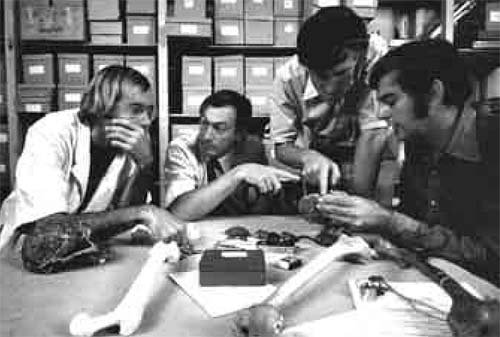 |
| Evolutionist scientists generally make deductions on the basis of a few fragments of bone in their possession. (Richard Leakey, second from left, and Donald C. Johanson on the far right.) |
Charles Darwin:
You ask whether I shall discuss "man";-I think I shall avoid whole subject... My work, on which I have now been at work more or less for 20 years, will not fix or settle anything...272
... but I was dreadfully disappointed about [the evolution of] Man.273
Richard Leakey - Roger Lewin (after a lengthy exposition of hypotheses regarding human evolution):
Isolated teeth, single bones, fragments of skulls: for the most part, these are the clues from which the story of human prehistory must be reconstructed.274
Dr. Robert Martin is senior research fellow at the Zoological Society of London:
In recent years several authors have written popular books on human origins which were based more on fantasy and subjectivity than on fact and objectivity. At the moment science cannot offer a full answer on the origin of humanity, but scientific method takes us closer to the truth...275
Richard Leakey, a well-known evolutionist:
David Pilbeam [a well-known expert in human evolution] comments wryly, “If you brought in a smart scientist from another discipline and showed him the meager evidence we've got, he'd surely say, 'Forget it: there isn't enough to go on.”276
Richard Leakey and Roger Lewin:
Many discoveries of supposed hominids consist of only a mouth fragment, a leg bone, a hip bone, or a knee joint.277
If someone went to the trouble of collecting into one room all the fossil remains so far discovered of our ancestors (and their biological relatives) who lived, say, between five and one million years ago, he would need only a couple of large trestle tables on which to spread them out. And if that were not bad enough, a not unusually commodious shoe box would be more than sufficient to accommodate the hominid fossil finds of between fifteen and six million years ago.278
The human mind has shown itself to be particularly fertile for generating notions about the nature of mankind, but only when those notions are subject to the scrutiny of different scientific disciplines can the more fanciful theories be weeded out. In learning about hominid history we have to be imaginative, but not fanciful, the inputs and caveats offered by the psychologists, taphonomists, and others create the right condition in which to be responsibly imaginative.279
F. Clark Howell, professor and chairman of the Anthropology Department at the University of Chicago, discusses Piltdown Man, one of the most notorious forgeries in history:
Piltdown was discovered in 1953 to have been nothing more than an ape's jaw placed with a human skull. It was a hoax placed on purpose. They recognized neither the jaw to be an ape's or the skull to be a human's. Instead, they declared each part as [from] an in-between [species] of ape and human. They dated it to be 500,000 years old, gave it a name (Eoanthropus Dawsoni or "Dawson's Dawn Man"), and wrote some 500 books on it. The "discovery" fooled paleontologists for forty-five years.280
Wray Herbert is psychology editor for Science News, editor-in-chief of Psychology Today, and science and medicine editor at US News & World Report:
According to John Hopkins University anthropologist Alan Walker, there is a long tradition of misinterpreting various bones as human clavicles; in the past, he says, skilled anthropologists have erroneously described an alligator femur and the toe of a three-toed horse as clavicles.281
Boyce Rensberger is author of popular science books and director of the Knight Science Journalism Fellowships program at the Massachusetts Institute of Technology:
In 1984, a 12-year old boy of the Homo erectus species, dated at 1.6 million years old, was dug up in Kenya. His body skeleton was virtually indistinguishable from our own.282
Jerald M. Loewenstein and Adrienne L. Zihlman in New Scientist, dated December 1988:
... anatomy and the fossil record cannot be relied upon for evolutionary lineages. Yet palaeontologists persist in doing just this.... The subjective element in this approach to building evolutionary trees, which many palaeontologists advocate with almost religious fervour, is demonstrated by the outcome: there is no single family tree on which they agree. On the contrary, almost every conceivable combination and permutation of living and extinct hominoids has been proposed by one cladist or another.283
 |
| David Pilbeam |
David Pilbeam is professor of social sciences at Harvard University and curator of paleontology at the Peabody Museum:
My reservations concern not so much this book [Richard Leakey's Origins], but the whole subject and methodology of paleoanthropology... Perhaps generations of students of human evolution, including myself, have been flailing about in the dark; ... our data base is too sparse, too slippery, for it to be able to mold our theories.284
Theory shapes the way we think about, even perceive, data... We are unaware of many of our assumptions.285
In the course of rethinking my ideas about human evolution, I have changed somewhat as a scientist. I am aware of the prevalence of implicit assumptions and try harder to dig them out of my own thinking...286
At least in paleoanthropology, data are still so sparse that theory heavily influences interpretations. Theories have, in the past, clearly reflected our current ideologies instead of the actual data.287
Roger Lewin is a well-known evolutionist writer:
In the physical realm, any theory of human evolution must explain how it was that an ape-like ancestor, equipped with powerful jaws and long, dagger-like canine teeth and able to run at speed on four limbs, became transformed into a slow, bipedal animal whose natural means of defense were at best puny. Add to this the powers of intellect, speech and morality, upon which we "stand raised as upon a mountain top," as Huxley put it; and one has the complete challenge to evolutionary theory.288
Robert B. Eckhardt is professor of anthropology at Penn State University:
Amid the bewildering array of early fossil hominids, is there one whose morphology marks it as man's hominid ancestor? If the factor of genetic variability is considered, the answer appears to be no.289
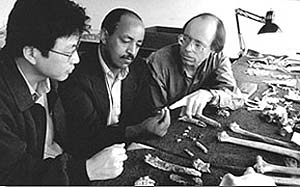 |
| Tim White on the far right |
Dr. Tim White is an evolution anthropologist at the University of California in Berkeley:
Perhaps no area of science is more contentious than the search for human origins. Elite paleontologists disagree over even the most basic outlines of the human family tree. [So-called] New branches grow amid great fanfare, only to wither and die in the face of new fossil finds.290
Lyall Watson has degrees in botany and zoology and is also doctor of philosophy degree in ethology under Desmond Morris at London Zoo:
Modern apes, for instance, seem to have sprung out of nowhere. They have no yesterday, no fossil record. And the true origin of modern humans-of upright, naked, tool-making, big-brained beings-is, to be honest with ourselves, an equally mysterious matter.291
William R. Fix is the author of the book, The Bone Peddlers:
As we have seen, there are numerous scientists and popularizers today who have the temerity to tell us that there is "no doubt" how man originated. If only they had the evidence...292
Dr. Tim White:
A five million-year-old piece of bone that was thought to be a collarbone of a human-like creature is actually part of a dolphin rib according to an anthropologist at the University of California, Berkeley... The problem with a lot of anthropologists is that they want so much to find a hominid that any scrap of bone becomes a hominid bone.293
In 1994, the American anthropologist Holly Smith conducted detailed analyses indicating that Homo habilis was not Homo-in other words, not human at all-but rather unequivocally an ape. Speaking of the analyses she made on the teeth of Australopithecus, Homo habilis, H. erectus and H. neanderthalensis, Smith stated:
Restricting analysis of fossils to specimens satisfying these criteria, patterns of dental development of gracile australopithecines and Homo habilis remain classified with African apes. Those of Homo erectus and Neanderthals are classified with humans.294
Stephen J. Gould:
What has become of our ladder if there are three coexisting lineages of hominids (A. africanus, the robust australopithecines, and H. habilis), none clearly derived from another? Moreover, none of the three display any evolutionary trends during their tenure on Earth.295
Evolutionist paleontologists Claude A. Villee is professor of biological chemistry at Harvard Medical School, Eldra P. Solomon is licensed psychologist at Center for Mental Health Education, Tampa, Florida, and Percival William Davis is a professor of life science at Hillsborough Community College:
We [humans] appear suddenly in the fossil record...296
Niles Eldredge and Ian Tattersall are paleontologists on the curatorial staff of the American Museum of Natural History.
It is a myth that the evolutionary histories of living things are essentially a matter of discovery. If this were true, one could confidently expect that as more hominid fossils were found, the story of human evolution would become clearer. Whereas if anything, the opposite has occurred.297
Henry Gee editor in Nature magazine:
... the chain of ancestry and descent... [is] a completely human invention created after the fact, shaped to accord with human prejudices.... To take a line of fossils and claim that they represent a lineage is not a scientific hypothesis that can be tested, but an assertion that carries the same validity as a bedtime story-amusing, perhaps even instructive, but not scientific.298
John Durant is a historian at Oxford University; from a meeting at the British Association for the Advancement of Science:
Could it be that, like "primitive" myths, theories of human evolution reinforce the value-systems of their creators by reflecting historically their image of themselves and of the society which they live?299
... Time and again, ideas about human origins turn out on closer examination to tell us as much about the present as about the past, as much about our own experiences as about those of our remote ancestors.... [W]e are in urgent need of the de-mythologisation of science.300
Darwinists use the following ancient method with regard to the fictitious evolution of man: they take fossils from an extinct gorilla or chimpanzee; that is an easy matter for Darwinists, because ONLY 200 OF THE 6000 MONKEY SPECIES THAT HAVE EVER EXISTED ARE STILL ALIVE TODAY. In other words, fossils from the remaining 5880 species are a perfect speculative tool for Darwinists.
In using these fossils, Darwinists generally come up with such illogical and utterly primitive scenarios as “all right, this is a monkey, but it has a curved thumb and so, it must be turning into a human being.” That idea is utterly illogical, but when these illogical accounts are published in world-renowned Darwinist magazines, when scientific language and terminology that mobody can understand are used and when the people saying these things are are professors who blindly defend Darwinism, in other words, when a lie is repeated over and over again, then the idea may seem quite convincing to people wihout much knowledge of the subject. Darwinists have been engaging in this unpleasant rrickery for years, taking advantage of people’s ignorance, the empact of the media and various propaganda techniques.
There are numerous instances of this.
In the case of Ardi, as always, Darwinists produced not an extinct species of monkey but a living thing identical to Bonobo chimpanzee living today. They then try to deceive people with statements such as “All right, the monkey is now standing upright.”
Darwinists took an ordinary monkey fossil and reconstructed its pelvic bone, which was shattered into tiny fragments just millimeters in size, in such a way as to show that it “could walk upright.” The sole reason why the fossil concerned was chosen as the best suited candidate for the fictitious scenario of human evolution is that the pelvic bone could be reconstructed “as they wished” by Darwinist scientists. Darwinists did what was needed for the sake of Darwinism and Ardi was shamelessly presented to the world as an “upright monkey.” It was, without any qualms, depicted as the greatest evidence for the myth of human evolution. But, like all the others , this furore was short-lived and the Darwinist fraud was quickly exposed. And in the example of Ardi, directly through statements by Darwinist scientists.
It is now time for them to apologise for Ardi.
William Jungers, the Darwinist departmental head of the anatomic sciences department at the Stony Brook, Long Island medical center, issued the following statement about the claims regarding Ardi being “the ancestor of man:”
I think some of the things they said might have been for effect.301
Tim White, a Darwinist from the University of California who studied Ardi and suggested it represented a missing link in the fictitous evolution of man, and his colleagues were forced to make the following statement:
There are no apparent features sufficiently unique to warrant the exclusion of Ar. ramidus as being ancestral to Australopithecus.302
The fact that the pelvic bone, a collection of tiny fragments, and the surrounding area were reconstructed according to Darwinist scientists’ preconceptions was openly expressed by other Darwinist scientists.
Jungers says this on the subject:
Maybe the pieces do fit together nicely, but the reality is they start out with a very damaged specimen, and they end up with something very similar to an australopithecine" (the group that includes "Lucy," the 3.2-million-year-old Australopithecus as well as a 2.7-million-year-old Paranthropus)... [Ardi] requires a lot of guesswork.303
After examining the fossil, Jungers explicitly stated, “after working with the fossils himself, there is no way that they could belong to an animal that wasn't often walking on its hind legs," unless the data "were deliberately ignored, or if we had made them up.”304 ”By that statement, Tim White and his team are admitting that they signed up to a new deception in the name of Darwinism.
It is not only findings regarding the pelvic bone that give the lie to the claims about Ardi. An article published in Science magazine said that the anatomy of its foot revealed that Ardi was a climber. Another article, by Katherine Harmon from Scientific American magazine, titled “How Humanlike Was Ardi?” explicitly stated that a single fragment from a foot was not sufficient to show that the animal stood erect. The feet, and particularly the big toes, exhibit features that still exist in present-day chimpanzees and that are useful in climbing. Jungers summarizes this situation as follows:
(Ardi) it really doesn't show any adaptations for bipedalism at all.305
Devoid of any evidence to support their claims, Darwinists are finally resorting to this deception in order to be able to depict this life form as a forebearer of human beings: “Its teeth are small, because while the males were off hunting, the females looked after the young.” This desperate claim is in fact significant evidence of the despairing situation in which Darwinists find themselves. Because they have no evidence, they have no hesitation about resorting to demagoguery instead. It is a disgrace for a scientist to make such a claim and declare, on that basis, that a literally flawless Bonobo chimpanzee is a forebearer of man. But even if Darwinists disgrace themselves they still reiterate these feeble claims in the name of their Darwinist ideology.
The claims made about the fossil known as IDA, that the Darwinist David Attenborough lauded as the missing link sought for so many years and that the press heralded under headlines such as “the ancestor of man” and “the eighth wonder of the world,” attracted powerful criticism even from Darwinist scientists.
Darwinists suddenly shone the spotlight onto a lemur fossil that had been sitting quietly for the previous twenty six years. Some Darwinist scientists were initially cautious and made moderate statements to the effect that “it is still too early to call the fossil a missing link.” But the proapaganda has reached such terrifying dimensions, and become so ,blatant, that even Darwinist scientists have had to react against this lie.
In an article on the ABC News web site titled “The Missing Link?” the Johns Hopkins University and Carnegie Museum of Natural History paleontologist Chris Beard says, “This fossil is not as close to monkeys, apes, and humans AS WE ARE BEING LED TO BELIEVE.”306 In another article, this time in New Scientist magazine, titled “Why Ida Fossil is Not The Missing Link?” Beard explicitly states that Ida has no characteristics resembling those of human beings, for which reason it cannot be described as a missing link. According to the Darwinist Beard, no matter how much research is done on it, Ida is not, in that sense, the eighth wonder of the world.307 Instead, Beard explicitly says that the fossil is a perfect one that will provide us with information about biology.
Richard Kay, a paleontologist from Duke University, openly admits that we have no scientific to support the claims that Ida is the missing link. In other words, THERE IS NO EVIDENCE AT ALL.308 Elwyn Simons, another Duke University paleontologist, has said that Ida tells us nothing we did not know before.309
The Timesonline web site carried the following criticism:
Attenborough... was just one element of the MEDIA CIRCUS turning Ida into humanity’s newest and best link with its ancient past.
Such finds are usually unveiled to the world through the sober pages of an academic journal, but for Ida nothing less than a glittering press conference at the American Museum of Natural History in New York would do. Later the scientists who studied Ida outlined the details of their research. Their pronouncements were just as extravagant.310
Of course all Darwinists are well aware that Ida is not an intermediate form, but rather a perfect living fossil. Contrary to all the speculation, Ida is a flawless life form that lived in a perfect manner some 47 milion years ago. The fossil has been 95% preserved, making it possible to study all its details, but it has NOT ONE STRUCTURE EXHIBITING INTERMEDIATE FORM CHARACTERISTICS. This extraordinary finding IS PROOF OF THE FACT OF CREATION.
This fossil, discovered in 2008 in the Malapa cave in South Africa, consisted of components belonging to two living things. Darwinists alleged that these “represented a complete skeleton.” But the fact is that these fossils consisted of a single skull and a few bones belonging to two living things. To put it more clearly, there was no complete skeleton of the kind alleged by Darwinists. But for Darwinists, who have no hesitations over producing wide-ranging reconstructions of a fictitious life form in a social setting on the basis of a single little finger, the amount of bones found was quite sufficient to engage in plentiful conjecture.
Darwinists, who are as yet unable to account for a single protein, claimed that this fossil was supposedly “our forebear.” But these two living fossils, with their height of just 1 meter, a skull volume of 420-450cc (much smaller than the 1200-1600cc skull volume of modern humans), long arms, identical to those of orangutans that permit them to climb trees, short legs and all their other characteristics, are clearly a species of ape. Yet despite all this evidence, they were still declared by Darwinists to be “life forms that walked upright.” This famous claim of bipedalism (walking upright) that evolutionists make in the context of every extinct species of simian, was again in this case of course completely unfounded. Not a single piece of evidence was produced. The fossils simply reveal that they belong to a species of simian. What they are trying to do, just as in the case of Ardi, is to invent a false intermediate form for supposed human evolution by portraying a perfect chimpanzee as walking on two legs. But, just as with Ardi, this claim is entirely unsupported by any evidence and is definitely a fabrication. Moreover, again as with the furore over Ardi, the majority of Darwinists have expressed their embarrassment over it all.
The strongest criticism of Darwinists, who declared a perfect, extinct simian fossil to be the forerunner of man by saying “we expect it walked upright,” even though all its physical characteristics suggested the exact opposite, came from Darwinists embarrassed by this illogical fanfare.
Hearing of the claim in question, the renowned Darwinist scientist Carl Zimmer challenged the deception being perpetrated regarding Ida and complained, “please, please, not again!” In an article on the Slate magazine web site, he said that Ida was first described as a “missing link” in the Telegraph, and then, with no loss of time, by other news channels. Zimmer noted that, although no information had been provided about the fossil, the reports in questions described it in excited language along the lines of “we have at long last found our ancestor.” When information about the fossil was published in Science magazine approximately one week later, the world found itself looking at the famous Australopithecus sediba. Zimmer continued:
… these fossils are certainly significant in a lot of ways, one thing they definitely are not is a missing link.311
Bill Jungers, from Stony Brook University in New York, said that the fossil in question had nothing whatever to do with the description Homo habilis and referred to it as another perfect simian.
In a report in Nature News, Michael Cherry said:
But the researchers' suggestion that the fossils represent a transitional species in human evolution, sitting between Australopithecus and Homo species, has been criticized by other researchers as overstated.312
One of the supporters of Lee Berger, who examined the fossil, said:
The Malapa specimens will rekindle the debate about the validity of the taxon Homo habilis.313
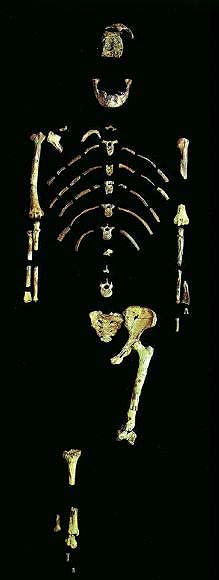 |
| The bones of “Lucy” |
During the course of research in Ethiopia's Hadar Desert in 1974, a 25% intact hominid skeleton estimated to be 3 million years old was discovered and was given the nickname "Lucy." This skeleton, which evolutionists claimed was of a forerunner of present-day man, was 1.20 meters high and had a skull volume of 410 cubic centimeters, which is very small, even by the standard of present-day apes.
Although evolutionists were perfectly well aware that Lucy was nothing more than an extinct form of ape, they ignored all her ape-like characteristics for the sake of the role as the ancestor of man that they had ascribed to her.
The fact is, however, that some Darwinists and Darwinist publications were forced to admit that this creature was nothing more than a monkey. The prestigious French scientific journal Science et Vie adopted Lucy as its cover story in May 1999. The report, titled "Adieu Lucy," stated that apes from the species Australopithecus should be removed from the human family tree.
Evolutionist scientists admitting that Lucy did not constitute evidence for the supposed evolution of man issued these statements.
Richard Leakey:
Echoing the criticism made of his father's habilis skulls, he added that Lucy's skull was so incomplete that most of it was "imagination made of plaster of Paris," thus making it impossible to draw any firm conclusion about what species she belonged to.314
Albert W. Mehlert is an evolutionist and paleoanthropology researcher:
The evidence given above makes it overwhelmingly likely that Lucy was no more than a variety of pygmy chimpanzee, and walked the same way (awkwardly upright on occasions, but mostly quadrupedal). The "evidence" for the alleged transformation from ape to man is extremely unconvincing.315
Jeremy Cherfas is an evolutionist author and has written many books on science:
Lucy, alias Australopithecus afarensis, had a skull very like a chimpanzee's, and a brain to match.316
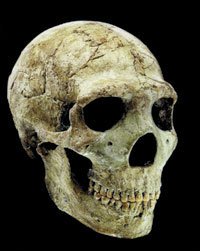 |
| A Neanderthal skull |
Neanderthals appeared suddenly in Europe around 100,000 years ago, disappearing again-or else assimilating with other human races-just as rapidly and silently 35,000 years ago. The only difference between these and present-day humans is that their skeletons were rather more powerful and their skulls, on average, slightly larger.
Neanderthals were a human race, and this is generally agreed upon by all. Evolutionists long attempted to portray these people as a primitive species, but all the findings showed that the Neanderthals were no different to any well-built individual walking down the street today.
For that reason, many contemporary researchers refer to Neanderthal Man as a present-day human race. Findings show that the Neanderthals buried their dead, used a variety of musical instruments and shared an advanced culture with Homo sapiens sapiens ("human" according to the imaginary classifications of Darwinists), living at the same time. In short, the Neanderthals were simply a large-bodied race of humans that gradually disappeared.
A great many evolutionist scientists, beginning with Charles Darwin himself, have had to recognize and admit this reality.
Charles Darwin:
Nevertheless, it must be admitted that some skulls of very high antiquity, such as the famous one of Neanderthal, are well developed and capacious.317
C. Loring Brace, an evolutionist anthropologist:
Neanderthals had short, narrow skulls, large cheekbones and noses and, most distinctive, bunlike bony bumps on the backs of their heads. Many modern Danes and Norwegians have identical features, Brace reported at the annual meeting of the American Anthropological Association in Phoenix... Indeed, the present-day European skulls resemble Neanderthal skulls more closely than they resemble the skulls of American Indians or Australian aborigines.318
Erik Trinkaus is professor of physical anthropology at Washington University in St. Louis:
Detailed comparisons of Neanderthal skeletal remains with those of modern humans have shown that there is nothing in Neanderthal anatomy that conclusively indicates locomotor, manipulative, intellectual, or linguistic abilities inferior to those of modern humans.319
From Prevention magazine, a pro-evolution periodical:
Dr. Francis Ivanhoe (London) solved the Neanderthal puzzle by having his research published in Nature magazine in August, 1970. Dr. Francis Ivanhoe has claimed that the teeth of Neanderthal Man show specific evidence of rickets (caused by a Vitamin D deficiency) and that X-rays of the bones of Neanderthal Man show the characteristic rickets ring pattern.320
He had a brain with a capacity sometimes larger than that of modern man. He was a talented toolmaker and successful hunter, even dabbled in art and, most importantly from a cultural standpoint, developed a rudimentary social and religious consciousness.321
Bonnie Blackwell is an evolutionist geologist at the City University of New York's Queens College:
Neanderthals were apparently quite similar to Homo sapiens in their behavior and cognitive capacities. In both groups, musical traditions probably extend back very far into prehistory. The Slovenian bone closely resembles several hole-bearing bones that were likely to have been used as musical instruments by humans at later European sites, according to archaeologist Randall K. White of New York University.322
Sarah Bunney is an executive editor and science writer:
Paleontologists in Israel have discovered a fossil bone which shows that Neanderthals may have been just as capable of speech as modern humans. The bone, known as the hyoid, is from a Neanderthal who lived between 50,000 and 60,000 years ago. The hyoid, a small U-shaped bone, is a key part of the vocal apparatus in modern human beings. According to B. Arensberg and Yoel Rak of Tel Aviv University and their colleagues, the fossil hyoid, in size and shape, is just like a modern human's... The researchers believe that, despite their heavy jawbones, Neanderthals spoke a language.323
The Neanderthals were a human race, with large, powerful muscles, who managed to survive in a harsh environment. Their tools remained the same for thousands upon thousands of years. There is no indication of evolution in their technology or behaviour.324
Milford Wolpoff is professor of anthropology at the University of Michigan:
Others helped a Neanderthal survive. Did they love him, did he make a valuable contribution to his community, were these his children and did they protect only their own relatives? Yes, we can invent all kinds of stories as to why this happened. The important thing is that these all belong to human beings. There are no animal fables and this behavior of theirs points to a social depth. They knew everything, and the Neanderthals lacked nothing of modern man's behavioral capacity...325
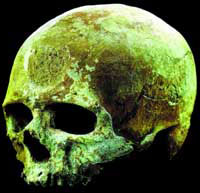 |
| A Cro-Magnon skull |
Cro-magnon fossils were first discovered in March 1868 in a cave in Les Eyzies in France. There is no major anatomical difference between these individuals and present-day humans, yet evolutionists try to use biased interpretations to portray Cro-Magnon Man as different from today’s human beings. In fact, Cro-Magnons were a human race now estimated to have lived around 30,000 years ago.
The skull structure of people living in Europe today does not resemble that of Cro-Magnons. Their skull structure and volume do, however, resemble that of some races currently living in Africa and tropical climes. On the basis of that resemblance, we can say that Cro-Magnons were an ancient race originating from Africa.
Cro-Magons disappeared very quickly. There is only one reason for that; paleoanthropological discoveries have shown that the Cro-Magnon and Neanderthal races combined with one another to form the basis of today's races.
Randall White is Professor of Anthropology at New York University:
Cro-Magnon artifacts have a right to stand alongside those of the entire history of mankind. From a 20th century perspective the extraordinary thing about the existence of Cro-Magnons is that they underwent no direct, gradual evolution from the crude and unformed to selectivity and perfection. The history of art begins 35,000 years ago.326
James Shreeve is a science journalist in magazines like Science, National Geographic and Smithsonian:
New dating methods have revealed that fossils thought to be 40,000 years old are actually 100,000 years old. Now, if Cro-Magnons are older than the Neanderthals who lived 60,000 years ago, how can they be descended from them?
Dorothy Great from Britain discovered both Neanderthal and Cro-Magnon remains in the Stark Hills behind Tel Aviv. Assumed that they were compatible with the previously estimated chronology, the Neanderthals were concluded to be around 60,000 years old, and the Cro-Magnons around 40,000. Some researchers were unconvinced. They believed that the stratification in the caves had been damaged by water currents and determined a new date using another dating method.
Eventually it was concluded that present-day humans appeared in the land of Israel before the Neanderthals. The new dating provoked considerable surprise, because it stated that modern-looking fossils were actually 100,000 years old. The Neanderthals, on the other hand, were 60,000 years old. On the basis of this evidence, Cro-Magnons cannot have evolved from the Neanderthals.
There are many scenarios concerning the extinction of species... These are full of assumptions. There is no evidence of any wars or violent conflict in these valleys. All there is, is a strange disappearance, and isolated fossils.327
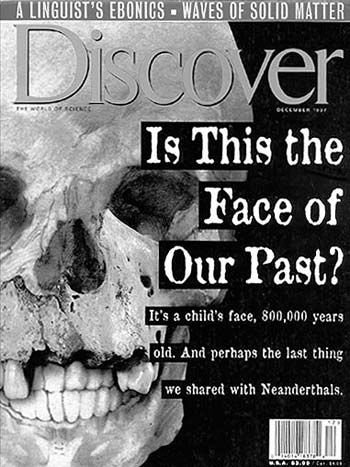 | The December 1997 edition of Discover, one of the most popular magazines with evolutionists, took an 800,000-year human face as its cover story, under the following caption, itself an expression of evolutionist amazement: “Is this the face of our past?” |
One of the human fossils that have attracted the most attention was one uncovered in 1995 in a cave called Gran Dolina in the Atapuerca region of Spain by three Spanish paleoanthropologists from the University of Madrid. The fossil revealed the face of an 11-year-old boy who looked entirely like today’s man. Yet the child had died 800,000 years ago. This fossil even shook the convictions of Juan Luis Arsuaga Ferreras, who led the Gran Dolina excavation. Ferreras said:
Arsuaga Ferreras:
We expected something big, something large, something inflated-you know, something primitive... And what we found was a totally modern face. . .To me, this is most spectacular-these are the kinds of things that shake you. Finding something totally unexpected like that. Not finding fossils; finding fossils is unexpected too, and it's okay. But the most spectacular thing is finding something you thought belonged to the present, in the past. It's like finding something like a tape recorder in Gran Dolina. That would be very surprising. We don't expect cassettes and tape recorders in the Lower Pleistocene. Finding a modern face 800,000 years ago-it's the same thing. We were very surprised when we saw it.330
|
Morpholological research into the footprints left behind by people who lived in the past has shown that these should be considered as modern-day prints. This truth is so obvious that even evolutionists have had to admit as much. | 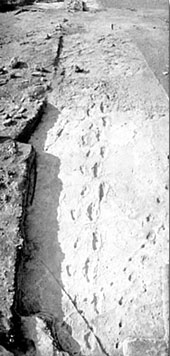 |
In 1977, Mary Leakey discovered footprints in the Laetoli region of Tanzania. These were in a stratum calculated to be 3.6 million years old and, even more importantly, were identical to those any present-day human being would leave. These footprints were later examined by eminent paleoanthropologists, evolutionist Tim White among them.
Tim White:
Make no mistake about it,... They are like modern human footprints. If one were left in the sand of a California beach today, and a four-year old were asked what it was, he would instantly say that somebody had walked there. He wouldn't be able to tell it from a hundred other prints on the beach, nor would you.329
Louise Robbins is the anthropologist who worked closely with Mary Leakey on the Laetoli project:
The arch is raised-the smaller individual had a higher arch than I do-and the big toe is large and aligned with the second toe... The toes grip the ground like human toes. You do not see this in other animal forms.330
Russell H. Tuttle is professor of anthropology at the University of Chicago:
A small barefoot Homo sapiens could have made them... In all discernible morphological features, the feet of the individuals that made the trails are indistinguishable from those of modern humans.331
In sum, the 3.5 million-year-old footprint traits at Laetoli site G resemble those of habitually unshod modern humans. None of their features suggest that the Laetoli hominids were less capable bipeds than we are. If the G footprints were not known to be so old, we would readily conclude that there were made by a member of our genus Homo... In any case, we should shelve the loose assumption that the Laetoli footprints were made by Lucy's kind, Australopithecus afarensis.332
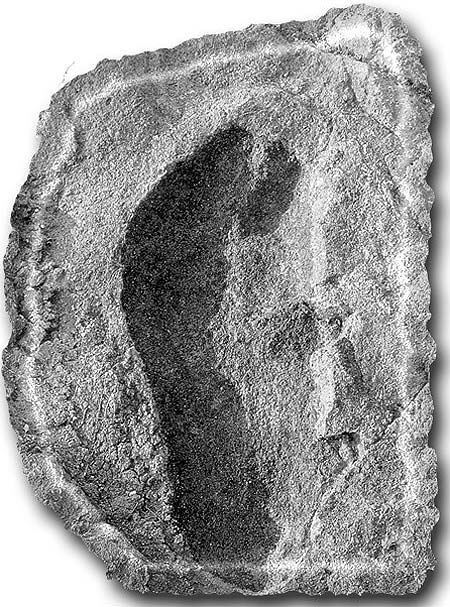 |
| Solely because of these prints' age, evolutionists ascribe them to A. afarensis. Research, however, shows that the people who left these footprints behind were not A. afarensis with prehensile hands and feet, but human beings identical to those living today. |
Elaine Morgan is an evolutionist writer and researcher for documentary television in Britain:
Four of the most outstanding mysteries about humans are: 1) Why do they walk on two legs? 2) why have they lost their fur? 3) why have they developed such large brains? 4) why did they learn to speak?
The orthodox answers to these questions are: 1) "We do not yet know"; 2) "We do not yet know"; 3) "We do not yet know"; 4) "We do not yet know." The list of questions could be considerably lengthened without affecting the monotony of the answers.333
Lord Solly Zuckerman is professor of anatomy at Birmingham University and chief scientific adviser to the British government:
We then move right off the register of objective truth into those fields of presumed biological science, like extrasensory perception or the interpretation of man's fossil history, where to the faithful, anything is possible-and where the ardent believer is sometimes able to believe several contradictory things at the same time.334
Lord Zuckerman candidly stated that if special creation did not occur, then no scientist could deny that man evolved from some apelike creature, without leaving any fossil traces of the steps of the transformation.335
Robert Eckhardt is Professor of Anthropology at Penn State University:
Neither is there compelling evidence for the existence of any distinct hominid species during this interval, unless the designation "hominid" means simply an individual ape that happens to have small teeth and a correspondingly small face.336
272- Francis Darwin, The Life and Letters of Charles Darwin, Vol. I, p. 467.
273- Francis Darwin, The Life and Letters of Charles Darwin, Vol. II, p. 298.
274- Richard Leakey, The Origin of Humankind (1994), p. ix.
275- Introduction to, and article by, Dr. Robert Martin (Senior Research Fellow, Zoological Society of London), 'Man is not an onion', New Scientist, 4 August 1977, pp 283 and 285.
276- Richard E. Leakey, The Making of Mankind, London: Michael Joseph Limited, , 1981, p. 43.
277- Richard Leakey and Roger Lewin, Origins, New York: E.P. Dutton, 1977, p. 111;David Johanson , and Edy Maitland, , Lucy, New York: Simon and Schuster, 1981. p. 157.
278- Leakey, R., & Lewin, R. People of the lake: Mankind and its beginnings. New York: Anchor Press/Doubleday, 1978, p. 17.
279- Richard E. Leakey and Roger Lewin, People of the Lake, Mankind and Its Beginnings (New York: Avon Books, 1979), p. 20.
280- F. Clark Howell, Early Man, New York: Time Life Books, 1973, pp. 24-25.
281- Herbert, Wray, "Hominids Bear Up, Become Porpoiseful," Science News, Vol. 123 (April 16,
1983), p. 246.
282- Boyce Rensberger, "Human Fossil is Unearthed," Washington Post, October, 19, 1984, p. 11.
283- Lowenstein, J. & Zihlman, A., "The Invisible Ape," New Scientist, Vol. 120, 3 December 1988, pp. 56, 58, 59.
284- David Pilbeam, American Scientist, Vol. 66, May-June, 1978, p. 379.
285- David Pilbeam, "Rearranging Our Family Tree," Nature, June 1978, p. 40.
286- David Pilbeam, "Rearranging Our Family Tree," Nature, June 1978, p. 44-45.
287- David R. Pilbeam, "Rearranging Our Family Tree", Nature, June 1978, p. 40.
288- Roger Lewin, Bones of Contention: Controversies in the Search for Human Origins, 1987, New York: Simon and Schuster, pp. 312-313.
289- Robert B. Eckhardt, "Population genetics and human origins," Scientific American, Vol. 226(1), January 1972, p. 94.
290- Robert Locke, "Family Fights" Discovering Archaeology, July/August 1999, p. 36-39.
291- Lyall Watson, "The Water People," Science Digest, May 1982, p. 44.
292- William R. Fix, The Bone Peddlers, New York: Macmillan Publishing Company, 1984, pp. 150-153.
293- Dr. Tim White, New Scientist, April 28, 1983, p. 199.
294- Holly Smith, American Journal of Physical Anthropology, Vol. 94, 1994, pp. 307-325.
295- S. J. Gould, Natural History, Vol. 85, 1976, p. 30.
296- Villee, Solomon and Davis, Biology, Saunders College Publishing, 1985, p. 1053.
297- Niles Eldredge, Ian Tattersall, The Myths of Human Evolution, pp. 126-127.
298- Henry Gee, In Search of Deep Time, New York: The Free Press, 1999, pp. 32, 116-117.
299- Roger Lewin, Bones of Contention, The University of Chicago Press, p. 312. 302- John R. Durant, "The Myth of Human Evolution," New Universities Quarterly 35 (1981), pp. 425-438.
300- John R. Durant, "The Myth of Human Evolution," New Universities Quarterly 35 (1981), pp. 425-438.
301- Katherine Harmon, How Humanlike Was "Ardi"?, Scientific American, 19 November 2009, How Humanlike Was "Ardi"?
302- Ibid.
303- Ibid.
304- Ibid.
305- Ibid.
306- The Missing Link? Nightline, ABC News television, May 20, 2009.
307- Chris Beard, “Why Ida fossil is not the missing link”, New Scientist, 21 May 2009, http://www.newscientist.com/article/dn17173-why-ida-fossil-is-not-the-missing-link.html.
308- Gibbons, A, "Revolutionary Fossil Fails to Dazzle Paleontologists,” ScienceNOW Daily News, posted on sciencenow.sciencemag.org, May 19, 2009.
309- Dayton, L, “Scientists divided on Ida as the missing link,” The Australian, posted on theaustralian.news.com.au, May 21, 2009.
310- http://www.timesonline.co.uk/tol/news/uk/science/article6350095.ece.
311- Carl Zimmer, Yet Another "Missing Link", Slate, posted April 8, 2010, http://www.slate.com/id/2250212/pagenum/all/#p2.
312- Michael Cherry, “Claim over 'human ancestor' sparks furore,” published online, 8 April 2010, http://www.nature.com/news/2010/100408/full/news.2010.171.html.
313- Ibid.
314- Richard Leakey, The Weekend Australian, 7-8 May 1983, p. 3.
315- Albert W. Mehlert, "Lucy-Evolution's Solitary Claim for Ape/Man," Creation Research Society Quarterly, Vol. 22, No. 3, (Dec 1985), p. 145.
316- Cherfas, Jeremy. "Trees have made man upright" New Scientist, Jan 20, 1983 pg. 172.
317- Charles Darwin, Descent of Man, Chapter II, "On The Manner Of Development Of Man From Some Lower Form"
318- C. Loring Brace, "Neanderthal Traits Extant, Group Told," The Arizona Republic (Phoenix), p. B-5,
319- Erik Trinkaus, "Hard Times Among the Neanderthals," Natural History, Vol. 87, December 1978, p. 10.
320- F. Ivanhoe, "Was Virchow Right About Neanderthal?," Nature, Vol. 227, August 8, 1970,pp. 577-579.
321- “Neanderthal Man, Victim of Malnutrition,” Prevention (October, 1971), p. 117.
322- "Neanderthal Noisemaker," Science News, vol. 15, (23 November 1996), p. 328.
323- Sarah Bunney, "Neanderthals Weren't So Dumb After All," New Scientist, Vol. 123, 1 July 1989, p. 43.
324- July 25, 1998, “Neanderthalles,” Discovery Channel.
325- Ibid.
326- July 25, 1998, “Neanderthalles,” Discovery Channel.
327- Ibid.
328- "Is This The Face of Our Past?" Discover, December 1997, pp. 97-100.
329- D. Johanson & M. A. Edey, Lucy: The Beginnings of Humankind, New York: Simon & Schuster, 1981, p. 250.
330- Science News, Vol. 115, 1979, pp. 196-197.
331- Ian Anderson, New Scientist, Vol. 98, 1983, p. 373.
332- Russell H. Tuttle, Natural History, March 1990, pp. 61-64.
333- Elaine Morgan, The Scars of Evolution, New York: Oxford University Press, 1994, p. 5.
334- Sir Solly Zuckerman, Beyond The Ivory Tower, New York: Toplinger Publications, 1970, p. 19.
335- Ibid., p. 64.
336- Robert Eckhardt, "Population Genetics and Human Origins," Scientific American, Vol. 226, 1972, p. 101.